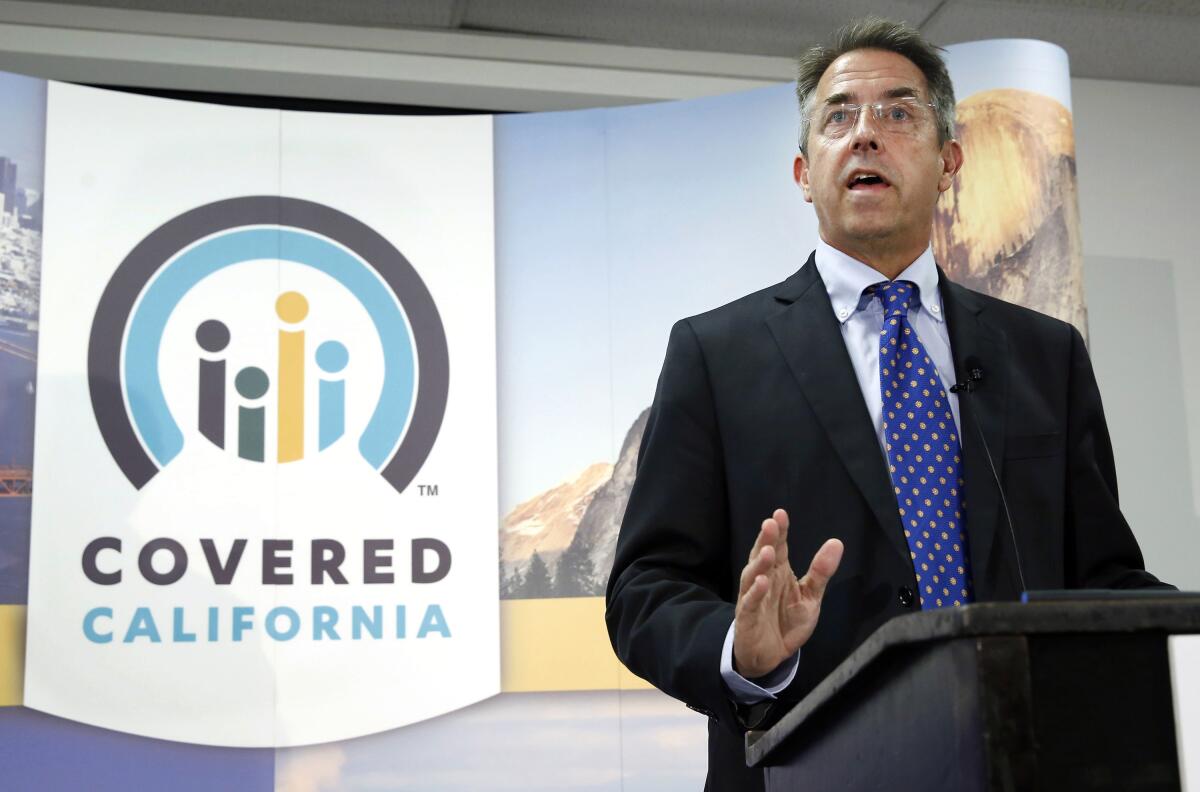Covered California enrollment nears 1.6 million as COVID-19 pandemic surges

- Share via
Nearly 1.6 million people have bought health insurance for 2021 through Covered California, state officials said Tuesday, a number that reflects the state’s high unemployment rate as millions of people have lost their jobs — and their employer-sponsored health coverage — during the pandemic.
Altogether, nearly 200,000 more people have bought health insurance for this year, up 14% from the year-earlier period. The deadline to purchase coverage for 2021 during open enrollment is Jan. 31.
“I anticipate we will end this year with more people than ever insured through Covered California, which is not great news for people who have lost their jobs,” Covered California Executive Director Peter Lee said. “They may have lost their jobs, but they don’t need to lose coverage.”
Covered California’s enrollment declined three years in a row until 2020, when a new state law took effect that imposes a tax on people who don’t have health insurance. The same year, California spent millions of dollars on subsidies to help middle-income earners pay their monthly health insurance premiums — the first and only state to do that.
Enrollment surged again last summer, peaking at 1.53 million people after an additional 289,000 people purchased coverage during a special enrollment period because of the coronavirus. The new number announced Tuesday — 1.57 million — comes after California again imposed a stay-at-home order on most of the state following a surge of new cases. On Monday, California’s tally of coronavirus-related deaths surpassed 30,000.
The latest maps and charts on the spread of COVID-19 in California.
Federal law lets people who don’t have health insurance through their jobs buy coverage from private insurers through a state marketplace. Most states let the federal government run their marketplace. But California has its own marketplace, called Covered California.
For people who buy a plan through the marketplace, the federal government will help some of them pay a portion of their monthly premiums, depending on how much money they make. California is the only state to offer additional assistance, meaning families of four that make as much as $154,500 per year could be eligible for subsidies.
Nearly 90% of people with health plans through Covered California get some type of financial help. On average, Lee said, that assistance covers 80% of a what the premium cost.
Covered California says that about 2.7 million of California’s nearly 40 million people don’t have health insurance, and that of those, about 1.2 million either are eligible for subsidies or could get government-funded health insurance at no cost through Medicaid.
Most of those people, about 718,000, live in Southern California, where the coronavirus outbreak is at its worst.
Dr. Tom Lawrie, chief medical officer at Sharp Memorial Hospital in San Diego, said he had five COVID-19 patients in the intensive care unit last weekend, all in their 30s, 40s or 50s, hooked up to heart-lung machines, which he described as “a last-ditch effort.”
“Without this type of technology, they wouldn’t be with us,” Lawrie said.
But the technology isn’t cheap, costing “in the neighborhood of $200,000 to $250,000 a week.”
“To think about having the insult of financial ruin piled on the injury of surviving a terrible illness like this seems unimaginable to me,” he said. “Anybody who doesn’t have insurance should go out and get it now. It is crucial for you and your families.”
Covered California’s budget comes from a small surcharge it collects on premiums. It has spent hundreds of millions of dollars in recent years on marketing and outreach, which include TV ads and paying social media influencers to tell their followers how to sign up for coverage.
Although Covered California is on pace to set a record for the number of people enrolled in health plans, Lee said its number of new enrollees has declined from last year, when a record number of new people purchased coverage to avoid a new state tax and take advantage of new subsidies.
More to Read
Inside the business of entertainment
The Wide Shot brings you news, analysis and insights on everything from streaming wars to production — and what it all means for the future.
You may occasionally receive promotional content from the Los Angeles Times.











